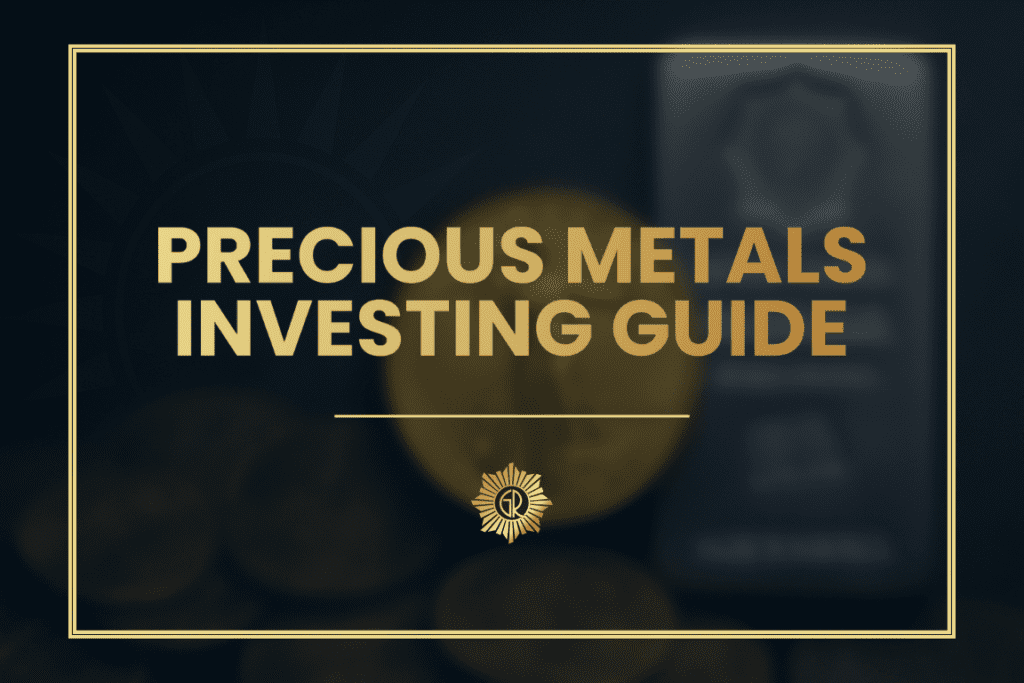Precious metals investing starts with allocating 5-10% of your portfolio to physical gold and silver. American Eagles provide the best liquidity for new investors. Secure storage and understanding dealer premiums determine investment success.
Key Investment Principles
- Allocate a small percentage of your total portfolio to metals
- U.S. Mint coins offer superior market acceptance
- Plan secure storage before making purchases
- Dollar-cost averaging reduces timing risk over months

Current Market Conditions
Global gold demand increased 8% year-over-year with investment demand rising 12%. The World Gold Council reports central banks purchased 337 tons in recent quarters, approaching record levels.
Institutional investors and governments turn to precious metals as hedges against currency devaluation. During the 1970s inflation crisis, gold prices rose from $35 to over $800 per ounce, preserving purchasing power when traditional investments struggled.
Understanding Pricing Components
Spot price represents the current market value for immediate delivery. This wholesale rate fluctuates throughout trading hours based on global supply and demand.
Dealers charge premiums above spot to cover manufacturing, distribution, and profit margins. Your total cost equals market price plus this markup.
Purity indicates metal content percentage. Eagles contain 91.67% gold (22 karat), while Buffalos contain 99.99% (24 karat).
Premium Calculation:
(Purchase Price – Spot) ÷ Spot × 100 = Premium %
Example: Eagle at $3,379 with spot at $3,300 equals 2.4% markup
Gold Investment Characteristics
Gold maintains purchasing power over decades. When stock markets face volatility or currencies lose value, gold often holds steady or appreciates.
Compact size simplifies storage compared to equivalent silver values. Universal recognition ensures easy selling worldwide. Lower price swings versus silver suit conservative investors. Historical performance during crises provides portfolio protection.
Silver Investment Benefits
Silver offers affordable entry for smaller budgets. Industrial applications in technology and energy sectors create additional demand beyond investment interest.
Price movements exceed gold’s volatility, offering greater profit potential with higher risk. Monthly purchases of $100-200 build meaningful positions over time. Electronics and solar panel manufacturing consume half of annual production.

Metal Comparison Chart
| Feature | Gold | Silver |
|---|---|---|
| Entry Cost | Higher ($3,300+ per oz) | Lower ($38+ per oz) |
| Space Required | Minimal | Substantial per dollar |
| Price Swings | Moderate | Significant |
| Industrial Demand | Limited | Extensive |
| Market Depth | Excellent | Very Good |
| Primary Purpose | Wealth preservation | Growth potential |
Most investors allocate 70% gold and 30% silver within their metals holdings.
Budget Planning Guidelines
Financial advisors recommend precious metals comprise a modest portion of diversified portfolios. Conservative investors typically allocate 5-7% while aggressive strategies may reach 15%. Most portfolios perform best within the standard 5-10% range.
Starting investments of $500-$1,000 allow learning without excessive risk. Build positions gradually rather than investing large amounts immediately.
Pre-Investment Checklist
Confirm these factors before buying:
- Emergency savings cover 3-6 months expenses
- Investment horizon exceeds three years
- Risk tolerance handles 20% value fluctuations
- Secure storage arrangements exist
- Tax consequences are understood
Meeting four criteria suggests readiness. Two or three indicates more preparation needed. One or none requires addressing financial fundamentals first.
Recommended Starter Products
Government coins trade most actively in resale markets. U.S. Eagles dominate domestic trading, ensuring quick sales nationwide.
Gold Eagles offer four denominations from tenth-ounce to full ounce, accommodating various budgets. Fractional sizes carry higher per-ounce costs but provide selling flexibility. Buffalos and Maple Leafs feature .9999 fineness versus Eagles’ .9167 alloy, though purity rarely affects resale values.
Silver Eagles command premium prices yet sell instantly anywhere. Maple Leafs and private mint rounds like Sunshine or SilverTowne offer better value while maintaining acceptable market recognition.
Established products ensure competitive pricing when selling. Avoid commemorative issues or limited editions that dealers discount heavily.
Finding Trustworthy Dealers
Reputable sellers display transparent pricing with itemized costs. Verify Better Business Bureau ratings and read customer experiences across multiple platforms.
Insured delivery protects shipments during transit. Professional gold and silver dealers answer questions thoroughly before accepting orders. Compare several sources since markups vary significantly between sellers.
GR Reserve Advantages
Competitive pricing beats most online dealers through direct wholesale relationships. Same-day shipping on orders placed before 2 PM expedites delivery. Precious metals specialists guide selection without pressure. Transparent costs eliminate surprise charges at checkout.
Calculating Total Purchase Costs
Three components determine final price: metal value, dealer markup, and delivery. Shipping rates depend on order size and speed requirements. State regulations dictate tax obligations for bullion purchases.
Compare complete costs between dealers rather than base prices alone. Percentage markups reveal true value since spot rates remain constant across sellers.
Storage Considerations
Physical ownership requires secure storage solutions scaled to collection value.
Home Safes Under $10,000
Quality safes withstand 30-minute fire exposure at minimum. Bolt units to concrete floors or wall studs to prevent theft. Concealed locations deter discovery. Verify homeowner’s insurance covers bullion holdings.
Professional Vaulting Services
| Service Type | Annual Fees | Security Rating | Access Hours |
|---|---|---|---|
| Bank Boxes | $50-200 | High | Banking hours |
| Private Vaults | $100-500 | Maximum | Extended |
| Dealer Programs | $150-400 | High | Appointment |
Select options matching collection size, access frequency, and comfort requirements.
Begin Building Your Metals Position

Physical gold and silver protect wealth during economic uncertainty. Understanding market pricing, dealer costs, and storage needs enables confident purchasing decisions.
GR Reserve brings over 100 years of precious metals expertise to guide your investments. As a family-owned business since 1915, we offer wholesale pricing previously exclusive to large buyers directly to individual investors.
Contact us today to discuss building your precious metals portfolio.



